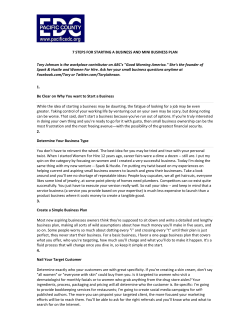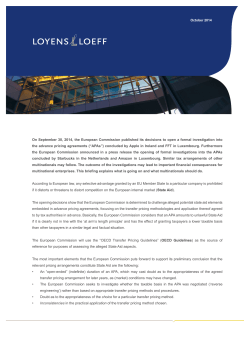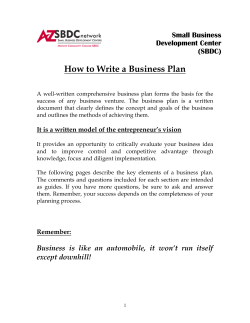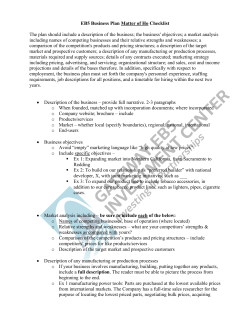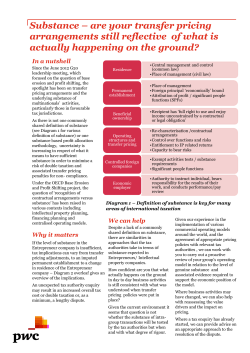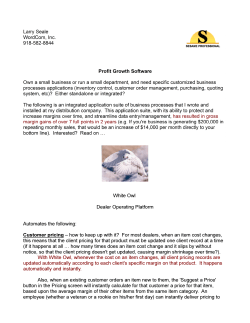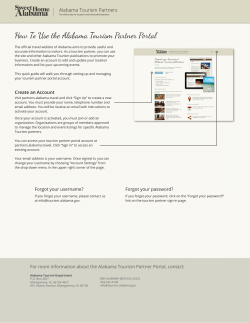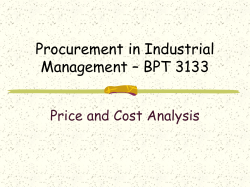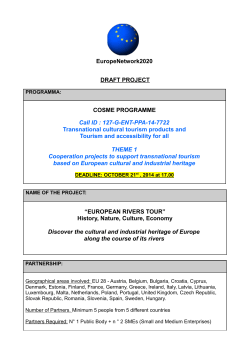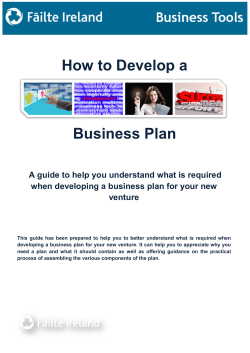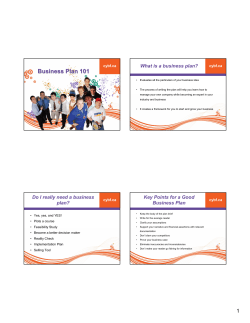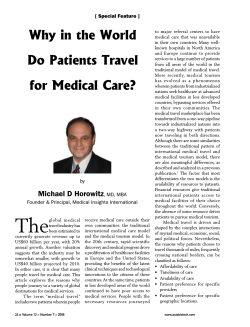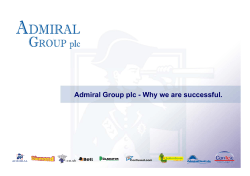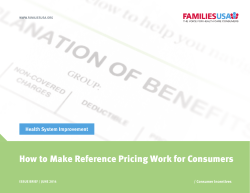
Marketing Plan
MODULE 5 Marketing Plan Introduction…………………………………………………………………… Projected Outcomes………………………………………………………….. Facilitator’s Notes..…………………………………………………………… Marketing Basics……………………………………………………………… Marketing Tasks (PRICE)…………………………………………………… 5 C’s of Market Research……………………………………………………. The Marketing Mix (The 4 P’s)……………………………………………… Tourism Marketing (The 8 P’s)……………………………………………… Target Markets……………………………………………………………….. Consumer Behavior…………………………………………………………… Consumer Buying Process…………………………………………………… Competition…………………………………………………………………… Product/Service Pricing……………………………………………………… Cost Based Pricing…………………………………………………… Break-Even Point…………………………………………………….. Pricing Strategies…………………………………………………………….. Skimming Strategy…………………………………………………… Penetration Strategy…………………………………………………. Demand-Oriented Strategy…………………………………………. Price Leadership Strategy…………………………………………… Competition-Oriented Strategy……………………………………… 68 69 69 70 71 72 73 74 76 77 77 79 80 80 81 81 82 82 82 83 83 67 MODULE 5 Marketing Plan Introduction: The majority of individuals asked, “what is marketing?” respond by explaining advertising. Marketing is the most critical component of all business plans. Marketing is the process of examining the wants and needs of others and then satisfying those needs with products and/or services. A popular slogan that describes marketing is “Find a need and fill it.” For the purposes of the E-Spirit competition the marketing module will only provide a superficial overview of the marketing process. This module will cover the basic 4 P’s of marketing, as well as a section on the 8 P’s of Tourism marketing. Team members should be encouraged to gather as much information as possible concerning their “market” as it increases the credibility of the business plan in the eyes of potential readers. In addition, the more information gathered, the greater likelihood of reaching your market effectively and efficiently. It is important to note that regardless of how much information is gathered, the decision to go into business is a leap of faith by the entrepreneur. 68 MODULE 5 Marketing Plan Projected Outcomes: Upon completion of Module 5, participants will increase or enhance: • • • • • • • • Research skills and abilities Understanding of marketing research practices and sources Awareness of the 4 P’s of marketing Understanding of marketing tasks Awareness of the importance of marketing Awareness and knowledge of the 8 P’s of Tourism marketing Awareness of pricing strategies Awareness of consumer behavior Facilitators Notes: Marketing is crucial to any business ventures’ survival. Knowing your market may mean the difference between success and failure. With all the information an entrepreneur requires to make an informed decision of whether to go into business or not, where do you start? We have included a section in this module with regards to research skills development, as it will be the primary task of the team members to gather appropriate data to support their business idea or case. 69 MODULE 5 Marketing Plan Marketing Basics: The Marketing Concept was introduced in the 1950’s and has been adopted as the standard for business. The marketing concept consists of three key components for marketing success: 1. Consumer Orientation - Consumer orientation refers to business examining business from the consumers’ perspective. Find out what the consumer wants and give it to them. 2. Training of Employees - - Training that is directed at achieving the businesses goals through customer satisfaction. Training co-ordinates and integrates marketing with activities of other departments Customer service is rapidly becoming a key component of all businesses 3. Profit Orientation - Refers to the business marketing products and/or services to the consumer that will earn a profit enabling the business to survive and grow - 70 MODULE 5 Marketing Plan Marketing Tasks (PRICE) 1. • • • 2. • P lanning What does the business want to achieve? How are you going to achieve your business goals? (what tasks need to be done and when) When do you want to accomplish the goals and objectives of the business? (milestones/benchmarks) R esearch (please refer to overhead transparency) • • The more you know about your customer the greater the likelihood of reaching them through marketing activities Identify competitions’ strengths and weaknesses What is the operating environment (legal, environmental, ethical, etc.) 3. I mplementation • Doing what your planning and research indicate is the most likely to achieve your goals and objectives 4. C ontrol • • • Controls refer to the systems put in place to monitor your marketing plan Controls should quantify results Who is doing what, when, and why 5. E valuation • Evaluate the performance of plan on a regular basis with partners 71 MODULE 5 Marketing Plan Marketing Research: In the previous module, we introduced the sources and rationale behind conducting business research. In this module we build on those skills by introducing the 5 C’s of market research. The 5 C’s of market research consist of the key rationale for making a business decision. Five C’s of Market Research: 1. C ustomers • Provide a detailed analysis of target market (who is going to purchase your product or service) • Information concerning age, gender, income levels, geographic location, education, trends, etc. should be examined • Why will the customer buy this product or service? 2. C ompetition • Who is your closest competition? • What are their strengths and weaknesses? • How does this compare to your product or service? 3. C onfidence • Research provides quantifiable and qualitative information • Increases investor confidence in business • Market research reduces the risk of business failure 4. C redibility • Research increases effectiveness of business strategy • Increases investor confidence in management credibility 5. C hange • Up-to-date research allows business to keep abreast of any market or technological changes 72 MODULE 5 Marketing Plan The Marketing Mix: The marketing mix is simply a process involving four key factors once you have identified a customer/market need. The four influencing factors are: 1. 2. 3. 4. A product or service that satisfies a need Setting a price for that product or service A place to sell that product or service Promoting that product or service to your market The four influencing factors are commonly referred to as the 4 P’s of Marketing, (Product, Price, Place, and Promotion). Managing the marketing mix is the process of planning and implementing the product/service concept, pricing, place (distribution), and promotion to influence purchasing decisions of the consumer that satisfies business and consumer goals. 4 P’s of Marketing: 1. P rice - Pricing of your product or service should be in line with industry averages Consumers must be willing to pay the price you are requesting Is your price reflective of brand recognition 2. P roduct - What makes your product or service standout? How can the consumer differentiate your product from the competition? How is your product perceived, low/high quality, low/high priced? 73 MODULE 5 Marketing Plan 3. P lace - Where will you conduct business? How will you transport or move your products and/or services to the industrial or consumer market? 4. P romotion - The process where entrepreneurs/marketers attempt to convince consumers to buy their product or service through utilization of the Promotional Mix. To have an effective efficient promotional mix the entrepreneur employs tools such as public relations, publicity, sales promotional activities, personal selling, advertising, and word-of-mouth promotion. How is your business going to promote your products and/or services? - - Tourism Marketing: The 4 P’s of marketing still apply to tourism related businesses, but there are other considerations for increasing business/marketing success. Tourism marketing employs the 8 P’s of Tourism Marketing, the original 4 P’s plus four more : 5. P eople - Tourism marketing requires people highly trained in customer service, problem solving, and communication skills What training or capacity building activities are required for your business venture? - 74 MODULE 5 Marketing Plan 6. P ackaging - Packaging refers to the entire tourism experience planned for your business Can your potential client get to your business easily? Do you have the capacity to “book” the entire trip for someone from another province or country? 7. P rogramming - Programming refers to specific tourism related activities for your business Do you have sightseeing tours, meet the artists, canoe/kayak trips, or cultural events that may attract customers? 8. P artnership - Partnership is a reality for most tourism specific businesses. Partnerships with airlines, bus companies, tour providers, travel agents, etc. are a key success factor in the tourism industry. Who would you partner with? - 75 MODULE 5 Marketing Plan Target Markets: Targeting a certain segment of the community and tailoring your products and services to that segment is referred to as target marketing. Target marketing is not limited to small market segments, only to segments that are homogeneous. Simply stated, your target market is the consumer that is most likely to purchase your product. An example of a large target market would be “yuppies” (young urban professionals). “Yuppies” account for more than 70% of new stereo sales; surprise, the major electronic manufacturers target the yuppie market. What factors should be researched in order to determine your target market? § Identify the characteristics of your potential customers. Look at your competition, who are they selling their products or services to? § Look at your potential clients’ income, education, interests, hobbies, purchasing patterns, etc. § If possible, back-up your information with questionnaires or survey results. Remember to state HOW you arrived at your results, HOW did you gather information and analyze that information. Example: XYZ Clothing envisions our target market to be young adults between the age of 17 and 30 years of age, above average income for that demographic, high school education plus, and located within 5 miles of our current location. Based upon statistics Canada 1996 Census there are approximately 20,000 individuals that fit XYZ Clothing’s target market profile. Current industry trends indicate that average market penetration in our industry is approximately 10% in the first year. Therefore, XYZ Clothing expects approximately 2000 customers in our first year of operation. 76 MODULE 5 Marketing Plan Consumer Behavior: We have discussed research and the importance of that process towards business success or failure, it is now time to discuss the customer. Why do customers purchase certain products or services over similar items? What is the typical consumers purchasing process? The majority of consumers who decide on purchasing a specific type of product and service typically follow a “buying process”. The following section provides a general overview of the buying process. Consumer Buying Process 1. Awareness • • The consumer must know about your product or service before they are able to purchase. Consumers typically become aware through advertisements, word of mouth, or other research sources 2. Information Gathering • • Media sources i.e. newspapers, television, magazines, trade publications, word of mouth, other? Allows comparisons between products and/or services 3. Evaluation • • Alternatives are evaluated against the individual’s criteria Decision is made concerning what product or service to buy 77 MODULE 5 Marketing Plan 4. Purchase • • 5. Consumer purchases product or service Consumer will now have an opportunity to use this product or service. Their feedback to the business and other potential or current customers will have a impact upon the business (if feedback is positive a possible increase in business, if feedback is negative you can count on business decreasing. Post-Purchase • The evaluation of your product or service by the consumer will have the greatest impact on your business. Negative feedback will have the most impact!! Remember the last time you purchased a product or service and were completely satisfied with, you probably did not tell everyone you know what a marvelous invention! Now think back when you purchased a product or service and felt like you were “taken”, how many people did you express your dissatisfaction about the product, service, customer service, warranty, etc. It is important to note that the customer has become increasingly more sophisticated and expects to be treated fairly and provided with a quality product or service. With the increased competition created by the global marketplace it is important to provide a product or service that the consumer wants and needs in an efficient and effective manner. 78 MODULE 5 Marketing Plan Competition: Without a doubt, almost every small business has competition in one form or another. Examining your competition to see what makes them successful or unsuccessful is a great source of information. How do they do business, in terms of customer service, location (ease of access for the customer), décor, etc? This is an excellent opportunity to highlight how your business can compete in terms of: § § § § § § § Price Service Location Product or Service Customer loyalty Business history Other? Can you offer better service, convenient location, lower prices, unique décor, etc? Investors will want to know why people who shop at other locations will want to frequent your business venture? Your target market has been identified; your competition has been examined; now how are you going to price your product or service??? 79 MODULE 5 Marketing Plan Product/Service Pricing: How do you set the price of your product or service? How much does the competition sell their products or services? That would be the starting point. Is your product or service unique or perceived to be unique? Remember XYZ Clothing; they sell trendy, brand name sweaters at approximately $50.00 each while their competition is selling their sweaters at approximately $25.00 each. XYZ is satisfying a perceived want, in this case trendy sweaters. XYZ sells fewer sweaters but makes more profit from each sale than the competition. Your target market must be able to pay for your products or services, so remember who is your customer?? Two common pricing strategies are Cost-Based Pricing and Break-Even Point Analysis. The ultimate objective of any marketing strategy is to create profits for the business. Pricing strategies assist in achieving that objective. How to price a product involves many factors that we will discuss briefly. Typically every product or service enters into a market place with many competing businesses. It logically follows then that prices are determined by many interactions between many buyers and sellers . But there are other influencing factors that affect pricing. Cost-based Pricing What does it cost to produce your product or service? Once you have figured that out, what do you want to make from each unit produced? Sounds simple doesn’t it. Costbased pricing is much more complex an issue than it appears. 80 MODULE 5 Marketing Plan Although beyond the scope of this competition the following example shows how factors not directly related to the product you see on the shelf influences the price of that product. Example: The cost to produce a bottle of vitamins is minimal, $1.00 or $2.00. Why are vitamins priced at $10.00 to $20.00+ for a bottle? The answer is, millions of dollars of research, testing, and government regulations had to be accounted for in the pricing of the vitamins. Break-Even Point: The break-even point for any business is the point beyond which a certain amount of sales, at a given price, results in profits for the company. How many units of product X have to be sold before you recoup the money you need to operate and profit? Pricing Strategies: How does an entrepreneur set the price of their product or service when entering the market place? Being first into a new market is not an assurance of success, A&W started the drive-in Fast Food in the 50’s and within a year or so numerous competitors were in the market. There are many strategies in price setting but keep in mind, who is your customer or “target market”? The following section will briefly discuss 5 of the more commonly utilized pricing strategies. 81 MODULE 5 Marketing Plan 1. Skimming Strategy: § This strategy involves setting the price of your product or service high in order to maximize profits while there is little competition or you are positioning your products or services as unique and therefore more expensive. (REMEMBER THE TARGET MARKET) § Low sales volume – High return 2. Penetration Strategy: § This strategy involves setting the price of your products or services low in order to attract customers from the competition. § This strategy allows businesses to “penetrate” or capture a large segment of the potential market. § High sales volume – Low return 3. Demand-Oriented Strategy: § This strategy involves setting the price of your product or service to meet consumer demand. In this strategy the cost of your product may not be a primary consideration when setting the price of your product or service. § Examples of this strategy include movie theatres that have differing prices based on age, drug stores and restaurants that offer senior discounts. § This strategy reflects the fact that different customers may be willing to purchase your products or services but a differing price, therefore meeting that consumers demand. 82 MODULE 5 Marketing Plan 4. Price Leadership Strategy: § This strategy involves following an industry leader and having your prices reflect those of the leader. § Have you ever wondered why all candy bars cost the same, or soft drinks? 5. Competition-Oriented Strategy: § This strategy bases the price of their product or service on what ALL of your competition is doing. § Price will depend on customer perceptions, business image, and consumer loyalty. § Prices can be below, above, or at competitors’ prices. 83
© Copyright 2025

